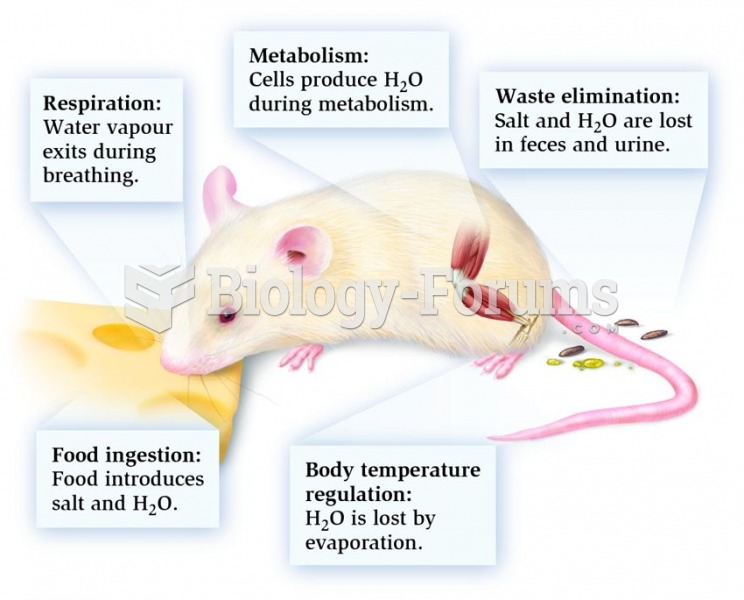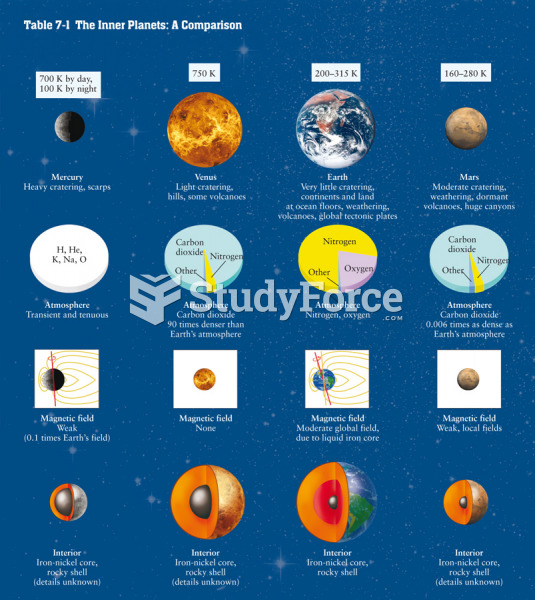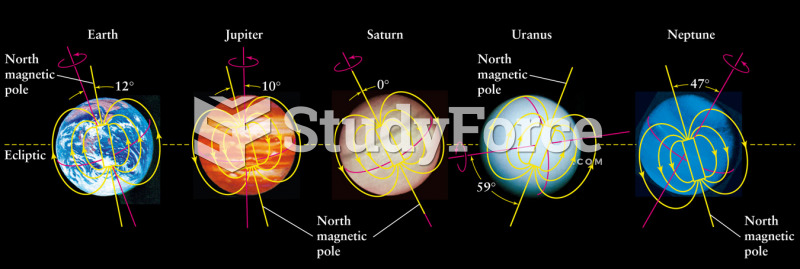The terrestrial planets and the Jovian planets are distinguished from each other in terms of
a. density only.
b. size only.
c. temperature only.
d. all of these.
Question 2
A wave in which the particle displacement is perpendicular to the wave motion is called a(n) ______________ wave.
Fill in the blank(s) with correct word
Question 3
In the operation of a laser
a. stimulated emission occurs.
b. there is a population inversion.
c. the excited state will tend to be metastable.
d. the photons emitted will have transitioned to the ground state.
e. For the answers (a), (b), (c), and (d), three are correct and one is incorrect.
Question 4
The Jovian planets
a. are composed mainly of hydrogen and helium.
b. have no solid surface.
c. have rings.
d. all of these.
Question 5
The frequency and the wavelength of a wave are ______________ proportional.
Fill in the blank(s) with correct word
Question 6
A headwaiter at a restaurant decides to apply the exclusion principle to the seating of patrons. He will treat tables as sub-shells, and will only seat patrons if the number of the people to be seated adds up to a complete sub-shell. Of the numbers below, the number he would not be willing to seat at one table is
a. 2.
b. 4.
c. 6.
d. 10.
e. 14.
Question 7
A terrestrial planet that has seasonal changes is
a. Venus.
b. Mars.
c. Mercury.
d. Saturn.
Question 8
If the wave frequency is doubled, the period of the wave is ______________.
Fill in the blank(s) with correct word
Question 9
Aline says that the magnetic moment of an atom originates in the orbital angular momentum of the electron. Bevis says that it comes from the electron spin. Which one, if either, is correct, and why?
a. Aline, because only atoms, not electrons, can have angular momentum.
b. Bevis, because only atoms, not electrons, can have angular momentum.
c. Neither, because electron spin and orbital angular momentum always cancel exactly.
d. Neither, because the magnetic moment of an atom comes only from the spin of the nucleus.
e. Both, because both the orbital angular momentum and the spins of the electrons contribute to the magnetic moment of an atom.
Question 10
The brightest object in the sky is
a. the Sun.
b. the Moon.
c. Venus.
d. Mars.
Question 11
The relationship of wave speed, wavelength, and frequency is given by ______________.
Fill in the blank(s) with correct word
Question 12
What is the difference in wavelength for spectral lines emitted by hydrogen for transitions from the n = 16 level to the n = 2 level and transitions from the n = 15 level to the n = 2 level? (RH = 1.097 107 m1.)
a. 1.0 1010 m
b. 2.0 1010 m
c. 4.1 1010 m
d. 8.1 1010 m
e. 1.6 109 m
Question 13
The second brightest object in the sky is
a. the Sun.
b. the Moon.
c. Venus.
d. Mars.
Question 14
The SI unit of frequency is ______________.
Fill in the blank(s) with correct word
Question 15
What is the difference in frequency for spectral lines emitted by hydrogen for transitions from the n = 16 level to the n = 2 level and transitions from the n = 15 level to the n = 2 level? (RH = 1.097 107 m1.)
a. 5.65 1013 Hz
b. 31 Hz
c. 1.77 1012 Hz
d. 2.55 1016 Hz
e. 1.02 1017 Hz
Question 16
The third brightest object in the sky is
a. the Sun.
b. the Moon.
c. Venus.
d. Mars.
Question 17
A wave with a frequency of 5 Hz will have a period of ______________ s.
Fill in the blank(s) with correct word
Question 18
In a completely filled atomic shell,
a. the intrinsic spin of the electrons does not produce a resultant magnetic moment.
b. the orbital motion of the electrons does not produce a resultant magnetic moment.
c. the atom will be an alkali metal.
d. only (a) and (b) are correct.
e. none of the above are correct.
Question 19
Which of the terrestrial planets has rings?
a. Mercury
b. Venus
c. Mars
d. None of the terrestrial planets has rings.
Question 20
All waves transfer ______________.
Fill in the blank(s) with correct word
Question 21
When electrons fill a subshell in which the orbitals have equal energy, the order in which the orbitals are filled is such that
a. a minimum number of electrons has unpaired spins.
b. a minimum number of electrons has intrinsic angular momentum.
c. a maximum number of electrons has unpaired spins.
d. a maximum number of electrons first fills the next energy level.
e. the maximum number of electrons has the same set of quantum numbers.
Question 22
Which of the following is not a terrestrial planet?
a. Earth
b. Mars
c. Jupiter
d. Venus
Question 23
A wave is a propagation of ______________.
Fill in the blank(s) with correct word
Question 24
Rubidium (Z = 37) and potassium (Z = 19) are similar to sodium in that they have ____ electron(s) in the outermost shell.
a. five p
b. three p
c. two s
d. one d
e. one s
Question 25
Which of the following is not a terrestrial planet?
a. Earth
b. Mars
c. Saturn
d. Venus
Question 26
What is the wavelength in meters, of a sound wave (v = 340 m/s) with a frequency of 4 Hz?
a. 85 Hz
b. 1360 Hz
c. 340 Hz
d. 0.012 Hz
Question 27
The ground state configuration of chlorine (Z = 17) is
a. 1s2 2s2 2p5 3s2 3p6
b. 1s2 2s2 2p6 3s2 3p5
c. 1s2 2s2 2p6 3s2 3p4 3d1
d. 1s2 2s2 2p6 3s2 3p5 4s1
e. 1s2 2s2 2p6 3s1 3p7
Question 28
How many minor planets are known to exist in the solar system, using today's classification system?
a. 1
b. 3
c. 2
d. 4
Question 29
What is the frequency, in hertz, of a sound wave (v = 340 m/s) with a wavelength of 68 m?
a. 5 Hz
b. 23120 Hz
c. 340 Hz
d. 0.2 Hz
Question 30
Characteristic x-rays can be produced by bombarding targets with electrons. These x-rays occur when
a. electrons from higher shells fill the vacant lower shell
b. electrons fill the vacant valence shell
c. photons are emitted with energies on the order of 103 eV
d. photons are emitted with wavelengths on the order of 103 nm
Question 31
According to today's classification system, how many major planets are there in the solar system?
a. 10
b. 9
c. 8
d. 11
Question 32
A stretched string can have ______________ natural frequency(ies).
a. one
b. 10 times its length in
c. 5 times its length in
d. many
Question 33
Forbidden transitions and selection rules suggest that
a. a photon has linear momentum.
b. a photon has energy.
c. a photon has angular momentum.
d. a photon has parity.
e. a photon has mass.
Question 34
Which of the following planets cannot be in opposition?
a. Mercury
b. Jupiter
c. Saturn
d. Mars
Question 35
When an oscillator is driven in resonance,
a. there are no standing waves.
b. any driving frequency may be used.
c. all natural frequencies are present.
d. there is maximum energy transfer.
Question 36
The Pauli Exclusion Principle states
a. no two electrons in the same atom can have the same set of quantum numbers.
b. there is an inherent uncertainty in the position and momentum of a particle.
c. when an atom has orbitals of equal energy, the maximum number of electrons will have unpaired spins.
d. when an atom has orbitals of equal energy, the maximum number of electrons will be paired spins.
e. no two atoms can have the same set of quantum numbers.
Question 37
Which of the following planets cannot be in opposition?
a. Venus
b. Jupiter
c. Saturn
d. Mars
Question 38
Resonance occurs when
a. two different objects vibrate with different frequencies.
b. two different objects produce beats.
c. an object having a certain natural frequency is set in vibration by a second object vibrating at that frequency.
d. an object produces a sound.
Question 39
In 1921, Stern and Gerlach performed an experiment that first demonstrated
a. orbital angular momentum quantization
b. energy quantization
c. space quantization
d. magnetic orbital quantization
e. that particles behave like waves
Question 40
Which of the following planets can be in opposition?
a. Mercury
b. Venus
c. Earth
d. Saturn
Question 41
Standing waves can be set up in a string when two waves that are
a. of the same frequency and amplitude, but are opposite in direction of travel, meet each other.
b. of the same frequency, amplitude, and direction of travel are also 180 out of phase.
c. of the same frequency, amplitude, and direction of travel meet each other.
d. of the same frequency, amplitude, and velocity meet each other.
Question 42
A Li2+ ion undergoes a transition from the n = 4 to the n = 3 state. The energy of the emitted photon is
a. 4.5 eV
b. 10.2 eV
c. 5.95 eV
d. 2.6 eV
e. 0.66 eV
Question 43
Which of the following planets can be in opposition?
a. Mercury
b. Venus
c. Earth
d. Neptune
Question 44
For the Doppler effect to occur, there must be
a. a moving source.
b. a moving observer.
c. relative motion between a source and an observer.
d. no motion.
Question 45
The energy needed to change a He+ ion in the ground state into a He2+ ion is
a. 13.6 eV
b. 54.4 eV
c. 112.4 eV
d. 92.9 eV
e. 27.2 eV
Question 46
Which of the following planets can be in opposition?
a. Mercury
b. Venus
c. Earth
d. Uranus
Question 47
A train sounding its horn is moving toward an observer. The pitch of the horn's sound relative to its normal pitch is
a. lower.
b. sometimes higher and sometimes lower.
c. higher.
d. the same.
Question 48
For the following allowed transitions, which photon would have the largest wavelength when an electron jumps from one energy level, characterized by the quantum number n, to another?
a. n = 2 to n = 1
b. n = 3 to n = 2
c. n = 3 to n = 1
d. n = 1 to n = 3
e. n = 4 to n = 1
Question 49
Which of the following planets can be in opposition?
a. Mercury
b. Venus
c. Earth
d. Mars
Question 50
During a thunderstorm, an observer notes that 10 s elapsed between the lightning flash and the sound of the thunder. What is the approximate distance, in miles, from the observer to the lightning?
a. 10 mi
b. 50 mi
c. 2 mi
d. 100 mi
Question 51
Of the following states, 5s, 3p, 4f, 5p, 4g, 3d, and 2p, the one which is NOT allowed is
a. 3p
b. 4f
c. 3d
d. 4g
e. 2p
Question 52
The terrestrial planets have
a. relatively high densities.
b. solid surfaces.
c. weak magnetic fields.
d. all of these.
Question 53
The Doppler effect is observed only when
a. the source of a wave moves toward a stationary observer.
b. there is relative motion between the source of a wave and an observer.
c. an observer moves toward the stationary source of a wave.
d. both the source of a wave and an observer are moving toward each other.
Question 54
The energy needed to remove an electron from the first excited state of a Li2+ ion is
a. 53 eV
b. 31 eV
c. 92 eV
d. 122 eV
e. 61 eV
Question 55
Which of the following planets moves the slowest in its orbit around the Sun?
a. Earth
b. Mars
c. Venus
d. Mercury
Question 56
Light can travel to Earth from a distant star, but sound cannot. Why is this?
a. Light is an electromagnetic wave, and sound requires a medium.
b. The Sun does not make sound.
c. Light is a longitudinal wave, and sound is a transverse wave.
d. The statement is false; both light and sound can travel in empty space.
Question 57
The number of states in the He+ ion corresponding to the principle quantum number n = 5 are
a. 18
b. 25
c. 50
d. 9
e. 11
Question 58
Which planet moves the fastest?
a. Earth
b. Mars
c. Venus
d. Mercury
Question 59
How many times greater is the speed of red light ( = 700 nm) than the speed of violet light ( = 400 nm) in a vacuum?
a. 1.75 , the first color of light is faster
b. 0.57 , the second color of light is faster
c. 3.00 108 , the first color of light is faster
d. 1.00 , both colors of light have the same speed
e. 3.00 108 , the second color of light is faster
Question 60
The allowed values of n for the Li2+ ion are
a. 1 to
b. 2 to
c. 3 to
d. any real number
e. 1 to 10
Question 61
The aberration of starlight gives proof that Earth is
a. rotating.
b. revolving.
c. precessing.
d. none of these.
Question 62
How many times greater is the speed of infrared light ( = 800 nm) than the speed of violet light ( = 400 nm) in a vacuum?
a. 2
b. 1/2
c. 400
d. 1; that is, both have the same speed.
Question 63
One of the main problems with the Bohr model of the hydrogen atom when compared with the results of the methods of quantum mechanics used to describe atoms, was that the Bohr model predicted
a. the ground state angular momentum was L = 1 .
b. the frequency of the radiation emitted when an electron jumps from one allowed orbit to another was hf = Ei Ef.
c. the potential energy function for the hydrogen atom was given by V(r) = ke2/r.
d. the energy of the ground state of the hydrogen atom was En = 13.6 eV.
Question 64
The planet Mercury
a. has retrograde motion.
b. is the closest planet to Venus.
c. is the smallest of the terrestrial planets.
d. has a uniquely circular orbit.
Question 65
A Doppler red shift indicates
a. a shift toward lower frequencies.
b. a shift toward shorter wavelengths.
c. that a light source is approaching relative to the observer.
d. none of these.
Question 66
Suppose Bohr had chosen the potential energy of the electron in the hydrogen atom to be V = 0 when the electron is in the orbit with n = 1 . He could do this by
a. choosing n = 1 for the orbit where the kinetic energy of the electron is zero.
b. adding a constant 13.6 eV to the potential energy for all values of n.
c. adding a constant 27.2 eV to the potential energy for all values of n.
d. subtracting a constant 13.6 eV from the potential energy for all values of n.
e. subtracting a constant 27.2 eV from the potential energy for all values of n.
Question 67
The planet Earth
a. has retrograde motion.
b. is the closest planet to Venus.
c. is the smallest of the terrestrial planets.
d. has a unique circular orbit.
Question 68
A Doppler red shift indicates
a. a shift toward higher frequencies.
b. a shift toward longer wavelengths.
c. that a light source is approaching relative to the observer.
d. none of these.
Question 69
An electron is moving at a speed of 2.1 106 m/s in the first Bohr orbit. Determine its de Broglie wavelength.
a. 0.30 1010 m
b. 1.7 1010 m
c. 0.50 1010 m
d. 3.5 1010 m
e. 1.5 1010 m
Question 70
The closest planet to Earth is
a. Mars.
b. Venus.
c. Mercury.
d. Saturn.
Question 71
A Doppler red shift indicates
a. a shift toward higher frequencies.
b. a shift toward shorter wavelengths.
c. that a light source is receding relative to the observer.
d. none of these.
Question 72
How fast is the electron moving in the first Bohr orbit?
a. 3.3 106 m/s
b. 2.2 106 m/s
c. 4.4 106 m/s
d. 5.5 106 m/s
e. 5.5 1015 m/s
Question 73
Stellar paralax proves that Earth is
a. rotating.
b. revolving.
c. precessing.
d. an oblate spheroid.
Question 74
A Doppler red shift indicates
a. a shift toward lower frequencies.
b. a shift toward longer wavelengths.
c. that a light source is receding relative to the observer.
d. all of these.
Question 75
A hydrogen atom is in its first excited state (n = 2). The linear momentum of the electron is (in kg m/s)
a. 3 1024
b. 2 1024
c. 1 1024
d. 4 1024
e. 3 1015
Question 76
The motion of a Foucault pendulum proves that Earth is
a. rotating.
b. revolving.
c. precessing.
d. an oblate spheroid.
Question 77
A Doppler red shift indicates
a. a shift toward higher frequencies.
b. a shift toward shorter wavelengths.
c. that a light source is approaching relative to the observer.
d. none of these.
Question 78
An electron in a hydrogen atom makes a transition from the n = 3 to the n = 1 energy state. Determine the wavelength of the emitted photon (in nm).
a. 1006
b. 209
c. 306
d. 103
e. 821
Question 79
Earth's axis is tilted ______________ degrees from the normal to the ecliptic plane.
a. zero
b. 90
c. 45
d. 23.5
Question 80
The threshold of hearing is
a. 0 dB.
b. 140 dB.
c. 40 dB.
d. 110 dB.
e. 1 dB.
Question 81
An electron in a hydrogen atom makes a transition from the n = 4 to the n = 3 energy state. Determine the energy (in eV) of the emitted photon.
a. 0.54
b. 0.66
c. 0.85
d. 1.51
e. 10.2
Question 82
Retrograde motion of a planet refers to ______________ motion.
a. west-to-east
b. east-to-west
c. circular
d. elliptical
Question 83
If a sound level increases by 40 dB, the intensity increases by a factor of ______________.
a. one hundred thousand
b. ten thousand
c. one thousand
d. one million
Question 84
Light is emitted by hydrogen atoms in the visible range for a hydrogen atom. Its wavelength is 656 nm. What value of n is associated with the light? (RH = 1.097 107 m1)
a. 5
b. 2
c. 4
d. 3
e. 6
Question 85
Kepler's third law of planetary motion is also known as the ______________ law.
a. periodic
b. elliptical path
c. harmonic
d. heliocentric
Question 86
The intensity of a 80-dB whistle is quadrupled. What is the new decibel level?
a. 80 dB
b. 68 dB
c. 89 dB
d. 320 dB
Question 87
What wavelength (in m) is associated with the Paschen series for n = 4? (RH = 1.097 107 m1)
a. 320
b. 530
c. 2.7
d. 1.9
e. 0.5
Question 88
The name given to the point of a planet's orbit that is farthest from the Sun is
a. aphelion.
b. focus.
c. perihelion.
d. solstice.
Question 89
The intensity of a 50-dB whistle is doubled. What is the new decibel level?
a. 50 dB
b. 47 dB
c. 53 dB
d. 100 dB
Question 90
What value of wavelength is associated with the Lyman series for n = 2? (RH = 1.097 107 m1)
a. 8.2 106 m
b. 1.2 107 m
c. 2.7 106 m
d. 3.6 107 m
e. 8.8 107 m
Question 91
The name given to the point of a planet's orbit that is closest to the Sun is
a. aphelion.
b. focus.
c. perihelion.
d. solstice.
Question 92
A sound level of 19 dB is how many times as intense as one of 10 dB?
a. 8
b. 9
c. 3
d. 18
Question 93
An energy of 13.6 eV is needed to ionize an electron from the ground state of a hydrogen atom. Selecting the longest wavelength that will work from the those given below, what wavelength is needed if a photon accomplishes this task?
a. 60 nm
b. 80 nm
c. 70 nm
d. 90 nm
e. 40 nm
Question 94
Kepler's first law states that the orbits of the planets around the Sun are
a. circles.
b. ellipses.
c. all lying in the same plane.
d. none of these.
Question 95
An increase of 40 dB increases the sound intensity by a factor of
a. 1000.
b. 40000.
c. 10000.
d. 4000.
Question 96
In the hydrogen molecule, H2, the separation between the protons is 1010 m. If the molecule is in its first rotational energy state, what is the angular velocity of the molecule about its center of mass?







